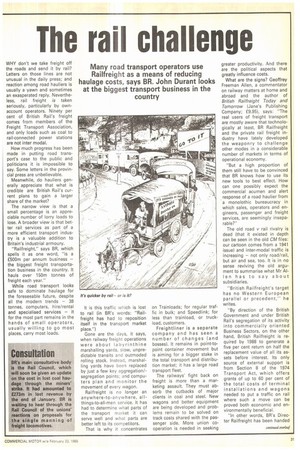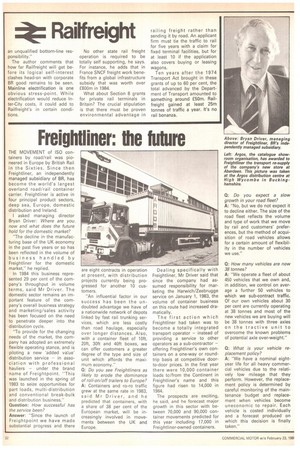The rail challenge
Page 33

Page 34

If you've noticed an error in this article please click here to report it so we can fix it.
WHY don't we take freight off the roads and send it by rail? Letters on those lines are not unusual in the daily press; and reaction among road hauliers is usually a yawn and sometimes an exasperated reply. Nevertheless, rail freight is taken seriously, particularly by ownaccount operators. Ninety per cent of British Rail's freight comes from members of the Freight Transport Association, and only loads such as coal to rail-connected power stations are not inter modal.
How much progress has been made in putting road transport's case to the public and politicians it is impossible to say. Some letters in the provincial press are unbelievable.
Meanwhile, do hauliers generally appreciate that what is credible are British Rail's current plans to gain a larger share of the market?
The narrow view is that a small percentage is an appreciable number of lorry loads to lose. A broader view is that better rail services as part of a more efficient transport industry is a valuable addition to Britain's industrial armoury.
"Railfreight," says BR, which spells it as one word, "is a £500m per annum business the biggest freight transportation business in the country. It hauls over 150m tonnes of freight each year."
While road transport looks safe to dominate haulage for the foreseeable future, despite all the modern trends 38 tonnes, computers, hire/rental and specialised services it for the most part remains in the hands of small operators, usually willing to go most places, carry most loads. It is this traffic which is lost to rail (in BR's words: "Railfreight has had to reposition itself in the transport market place.") Gone are the days, it says, when railway freight operations were about labyrinthine marshalling yards, slow, unpredictable transits and outmoded rolling stock. Instead, marshalling yards have been replaced by just a few key aggregation!segregation points; and computers plan and monitor the movement of every wagon.
Railfreight is no longer an anywhere-to-anywhere, allthings-to-all-men service. It has had to determine what parts of the transport market it can serve well and what parts are better left to its competitors.
That is why it concentrates on Trainloads; for regular traffic in bulk; and Speedlink; for less than trainload, or truckload, customers.
Freightliner is a separate company and has seen a number of changes (and bosses). It remains in point-topoint container movement but is aiming for a bigger stake in the total transport and distribution market; it has a large road transport fleet.
The railways' fight back on freight is more than a marketing assault. They must absorb the cutbacks of major clients in coal and steel. New wagons and better equipment are being developed and problems remain to be solved on track costs shared with the passenger side. More union cooperation is needed in seeking greater productivity. And there are the political aspects that greatly influence costs.
What are the signs? Geoffrey Freeman Allen, a commentator on railway matters at home and abroad and the author of British Railfreight Today and Tomorrow (Jane's Publishing Company; £9.95), says: "The real users of freight transport are mostly aware that technologically at least, BR Railfreight and the private rail freight industry have lately developed the weaponry to challenge other modes in a considerable number of markets in terms of operational economy.
"But a high proportion of them still have to be convinced that BR knows how to use its new tools to best effect. How can one possibly expect the commercial acumen and alert response of a road haulier from a monolothic bureaucracy in which sales, operators and engineers, passenger and freight services, are seemingly inseparable?"
The old road v rail rivalry is dead (that it existed in depth can be seen in the old CM files: our cartoon comes from a 1941 issue) and inter-modal traffic is increasing not only road/rail, but air and sea, too. It is in no sense reviving the old argument to summarise what Mr Allen has to say about subsidiaries.
"British Railfreight's target has no Western European parallel or precedent," he writes.
"By direction of the British Government and under British Rail's segregation of its activity into commercially oriented Business Sectors, on the other hand, British Railfreight is required by 1988 to generate a five per cent return on half the replacement value of all its assets before interest. Its only source of external support is from Section 8 of the 1974 Transport Act, which offers grants of up to 60 per cent of the total costs of terminal installations and wagons needed to put a traffic on rail where such a move can be proved both economic and environmentally beneficial.
"In other words, BR's Director Railfreight has been handed an unqualified bottom-line responsibility."
The author comments that how far Rai'freight will get before its logical self-interest clashes head-on with corporate BR good remains to be seen. Mainline electrification is one obvious stress-point. While electrification would reduce Inter-City costs, it could add to Rai'freight's in certain conditions. No other state rail freight operation is required to be totally self supporting, he says. For instance, he adds that in France SNCF freight work benefits from a global infrastructure subsidy that was worth over E800m in 1984.
What about Section 8 grants for private rail terminals in Britain? The crucial stipulation is that there must be proven environmental advantage in railing freight rather than sending it by road. An applicant firm must tie the traffic to rail for five years with a claim for fixed terminal facilities, but for at least 10 if the application also covers buying or leasing wagons.
Ten years after the 1974 Transport Act brought in these grants of up to 60 per cent, the total advanced by the Department of Transport amounted to something around E50m. Railfreight gained at least 25m tonnes of traffic a year. It's no rail bonanza.




















































































